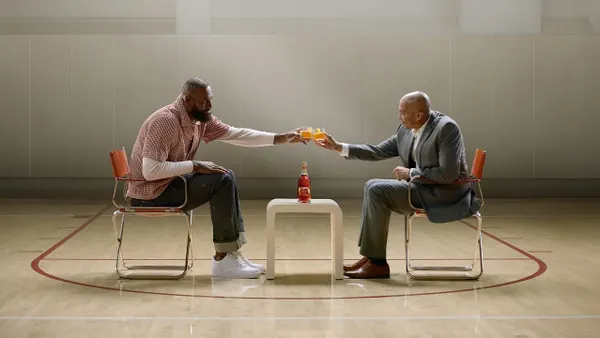Campaign Trail is our analysis of some of the best and worst new creative efforts from the marketing world. View past columns in the archives here.
Exploring the intersection of art and science, Polaroid's latest campaign celebrates human experiences and examines what it takes to capture these moments, drawing parallels between human chemistry and the film chemistry that occurs with the click of a camera.
A new emotive film, split into three ads, shows a man photographing a quiet scene with a woman as light illuminates the room, followed by shots in a Polaroid factory and clips of daily life engraved into retro instant film. The spots aim to illustrate how capturing these moments in a tangible photo — powered by an 83-year-old brand like Polaroid — is relevant in today's environment where people can digitally snap and store thousands of pictures.
With the world slowly reemerging from the coronavirus pandemic, values of connection and togetherness depicted in the spot have crystallized for many consumers. The limited nature of instant film forces people to take care when snapping a photo, elevating the level of connection they have to the "physical artifact" they've created, John Filipe, creative director at Ridley Scott Creative Group, told Marketing Dive.
"For me, Polaroid is a symbol that reminds us there's a way to make moments meaningful. Shooting in film, you pay a different level of respect and pay more attention. You go to a different mindset," he said.
Bringing clarity to the digital era
The "Forever Now" effort, which launched on May 27, signals a new creative direction for Polaroid following a brand refresh in March. The campaign is designed to encapsulate the world's collective mood mid-pandemic, when most consumers are at home and slowing down, allowing for more time to connect with themselves and loved ones. The three spots that make up "Forever Now" feature all-new footage and real Polaroid employees, according to details shared by the brand.
The company and Ridley Scott Creative Group began shooting the ads in early January before the novel coronavirus made its way around the world. Post-production occurred while the team worked remotely under lockdown, forcing a lengthier process and a heightened level of collaboration, Filipe said.
While the new creative emphasizes treasuring life's simple moments, Polaroid isn't looking to downplay the role of digital photography and smartphone cameras in today's fast-paced culture.
"When you take a picture with your iPhone, it's just a different process that you might not respect as much. It's something where you don't have much skin in the game," Filipe said. "We were never fighting iPhones or digital. Those have [their] place in culture, but Polaroid is not something you use to take 1,000 pictures. You use it to create a very important artifact that you don't trash. It speaks to you on a different level."
That messaging around appreciating moments and deepening connections through analog photography signifies a shift in Polaroid's creative strategy, which previously relied on nostalgia for the brand that launched in 1937 and has seen a revival in recent years as consumers show a hunger for classic products and experiences. In October 2019, Polaroid hosted pop-ups in New York and Paris to showcase a machine that creates prints from images projected by a smartphone screen.
"Even today, there's a bit more awareness of what really matters in the world. People care a little more about keeping things real."

John Filipe
Ridley Scott Creative Group, creative director
Fast forward to today, "Forever Now" was designed to bring more clarity to the brand and what it stands for in the digital era.
"We see a little more awareness in matters of the world, and digital is one of them," Filipe said. "Even today, there's a bit more awareness of what really matters in the world. People care a little more about keeping things real."
A comeback story
This campaign and broader brand revamp are the latest chapters in Polaroid's comeback story. The advent of digital cameras and smartphones forced the company to file for bankruptcy twice between 2001 and 2009 and go through six CEOs in as many years. In 2017, CEO Oskar Smolokowski's family bought Polaroid and pivoted the brand to focus on innovation in modern product categories and embracing newer marketing approaches to attract tech-savvy consumers, such as leveraging social media, user-generated content, experiential activations and influencers.
Now, it's diverging slightly from that messaging of fully embracing today's tech and integrating its products with modern platforms like iPhone and drone cameras, instead focusing on positioning Polaroid as a separate use case with a purpose distinct from digital photography.
"As the world continues to change around us, we're still drawn to the experiences that make us human. It's in our DNA," Smolokowski said in emailed statements.













